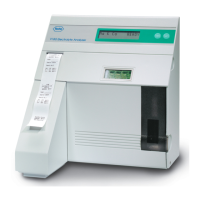Roche Diagnostics
Instructions for Use · Version 10.0 99
9180 Electrolyte Analyzer 7 Measurement
Preanalytics
Preanalytics
Sample collection
Safety
WARNING
Inappropriate collecting and handling of samples of human origin may result in
infection
Inappropriate collecting and/or handling samples of human origin may lead to the
transmission of blood or urine borne pathogens.
r Follow standard laboratory practices.
r Wear appropriate personal protective equipment.
r If a sample of human origin is spilled, wipe it up immediately and apply a disinfectant.
r If a sample of human origin comes into contact with your skin, wash the affected area
immediately with soap and water an apply a disinfectant. Consult a physician.
u CLSI document M29-A4 “Protection of Laboratory Workers from Occupationally
Acquired Infections; Approved Guideline—Fourth Edition, (2014)”.
Sample requirements
Blood for analysis has to be drawn by qualified personnel.
WARNING
Incorrect patient results due to inappropriate sample collection practices
Squeezing the puncture site adds tissue fluid to the blood sample and may lead to the
premature onset of clotting despite sufficient heparinization of the sample collection
containers. This may lead to errors and discrepancies in the measurement values.
r Do not squeeze the puncture site before collecting your blood sample.
r Use the correct sample container for your measurement. If you use the analyzer to
determine Li
+
results, use lithium-free sample containers.
u CLSI document H11-A4 “Procedures for the Collection of Arterial Blood Specimens;
Approved Standard—Fourth Edition, (2004)”.

